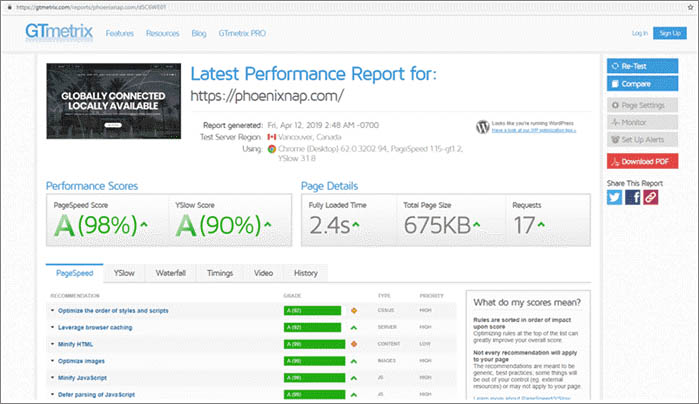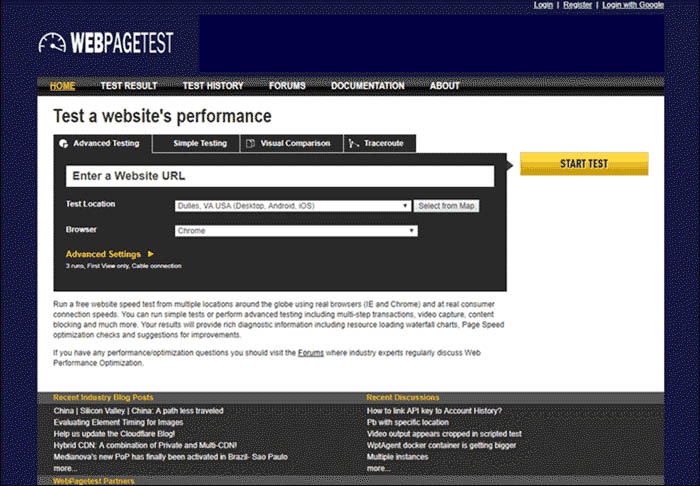Improve your website performance with online tools for testing.

Optimizing for quality of user experience is key to the long-term success of your website. Online performance tools can help you quantify the experience of your site and identify opportunities to improve.
Google has conducted research to determine an accurate way to measure when a web page has finished loading. It uses a metric called Largest Contentful Paint (LCP). LCP measures when the largest element was rendered.
Largest Contentful Paint (LCP): measures loading performance. To provide a good user experience, LCP should occur within 2.5 seconds of when the page first starts loading.

As currently specified in the Largest Contentful Paint API, the types of elements considered for Largest Contentful Paint are:
<img>elements<image>elements inside an<svg>element<video>elements (the poster image is used)- An element with a background image loaded via the
url()function (as opposed to a CSS gradient) - Block-level elements containing text nodes or other inline-level text elements children.
Take special note of <img> elements. “img” refers to images on your page. Image size is one of the biggest items that will slow down a page load. There are many third-party tools that allow you to see how your page is performing.
Online performance tools that provide data for website performance:
- GTMetrix (free and paid)
- Site 24×7 (free and paid)
- WebPage Test (free)
- Varvy Pagespeed Optimization (free)
- Google PageSpeed Insight (free)
- Pingdom (free and paid)
- Uptime (paid)
With the help of these tools, you can monitor the speed and performance of your website.
1. GTMetrix

GTmetrix is an online application for testing web page speed. This is my favorite tool for testing web page speed. It is totally free and very intuitive to understand. It offers free insight into page performance without a fee or even registration. Just visit the website, copy the URL of the page you wish to analyze and see the results. If you need more detailed monitoring, create a free account, or sign up for the paid version.
The results include performance scores, represented by grades from A to F for page speed and YSlow (a tool that tells you why your page is slow). Also, GTmetrix provides page details like page load time, its totals size, and the number of requests.
2. Site 24×7
Site 24×7 is an alternative to Pingdom that offers a free version, along with small or premium plans.
This budget-friendly tool provides website, network, server, and application monitoring. User feedback for real user monitoring is also included. You can use it on Windows, Linux, FreeBSD, and OS X. The paid plan covers five complete server monitors and 50 alerts per month. The free version is limited to 5 server uptime monitors and ten alerts per month.
3. WebPage Test

WebPageTest is a free testing tool that runs speed tests from multiple locations around the world.
It takes into account the type of browser, device, connection speed, and cache state the user has to obtain concrete results. It offers advanced and straightforward testing, a visual comparison, and traceroute examination.
Advanced testing allows you to decide on the number of tests you want to run, get first and repeat view of the web page and capture of a video of the visual progress of loading.
4. Varvy Pagespeed Optimization
Varvy Pagespeed Optimization is a free, online tool used for optimizing speed.
After entering the web page URL, it gives you a summary and a 5-part report. The report examines your resources, CSS delivery, JavaScript usage, services, and page speed issues. Varvy has a useful selection of resource articles and tutorials to help you improve performance. The tool also has an entire section dedicated to SEO and mobile optimization guides.
5. Google PageSpeed Insight

Google PageSpeed Insight is an excellent free page speed testing tool.
Once you insert the URL of the page you want to check, it gives you an overall score for page speed. Based on that score, it tells you whether the web page is fast, average, or slow. There are two different scores you can earn – one based on the website’s mobile performance and the other on its desktop performance. Most importantly, the tool provides advice on how to optimize response time.
6. Pingdom

Pingdom is one of the best performance monitoring services for business.
It provides web performance monitoring and uptime alerts by the minute. The tool gives an in-depth insight into page speed and performance expectations with SMS or email notifications. However, it does not have a free version. If you are unsure whether to commit to a subscription, try using its free 14-day trial.
Credit: https://phoenixnap.com/kb/best-website-speed-performance-test-tools
RELATED PAGES:



